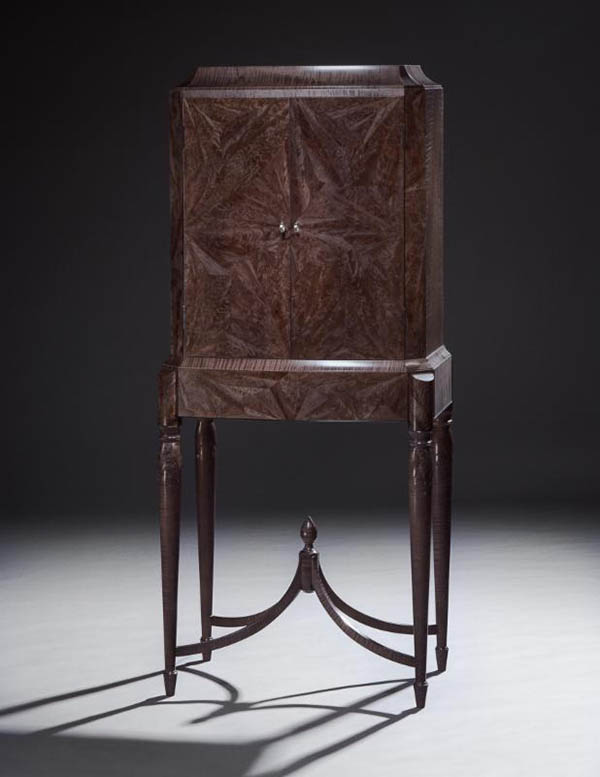
As the National Park Service celebrates its 100th anniversary this month, New Hampshire furniture maker David Lamb has recently completed a woodworking project honoring one specific national park, Acadia in Maine, which is also celebrating its centenary in 2016.
The project began with what David referred to as a “wonderful idea” from Tyra Hanson, owner of The Gallery at Somes Sound, to commission a furniture piece to commemorate Acadia’s 100th anniversary. David’s original presentation focused on his idea to represent the extreme weather conditions experienced in northern New England, particularly black ice (more on that shortly) via wood, but the conversation among David, the gallery owner and the patron broadened the scope of the piece so that it represented all four seasons.
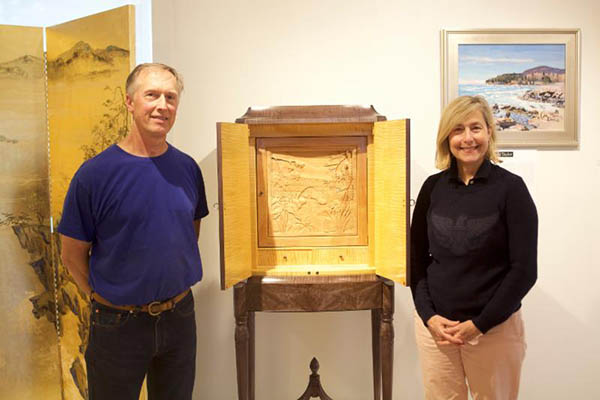
About that black ice. “It had been in my mind for some time, the idea of ice, of using wood as a way to speak to ice crystals,” David said. In fact the thought process likely started long ago, when he was living in a Shaker home in Canterbury Shaker Village, New Hampshire, where his parents for a time ran the museum. “We would see spectacular hard winter frost creations on glass” in the windows of the house, David said, citing the fern-like structures.
Later, he started noticing early ice formations on ponds and puddles, which was black due to the water below it. “You don’t have light coming through like windows, but it’s still the same ice crystals,” he said. “I found it totally captivating.” David took pictures of ice on cars and on his house’s metal roof; “I would walk the dog and think about it,” he said.
As he started experimenting with how to convey ice in wood, he eventually recognized a similarity between frost patterns and the grain of birch wood, especially the crotch wood. “It’s naturally a blond wood, so it lends itself to the idea of frost, which is naturally white or a little gray or, if the sun is shining through it first thing in the morning, even a little golden.” To achieve the look of black ice, he started experimenting with black dye over the wood.
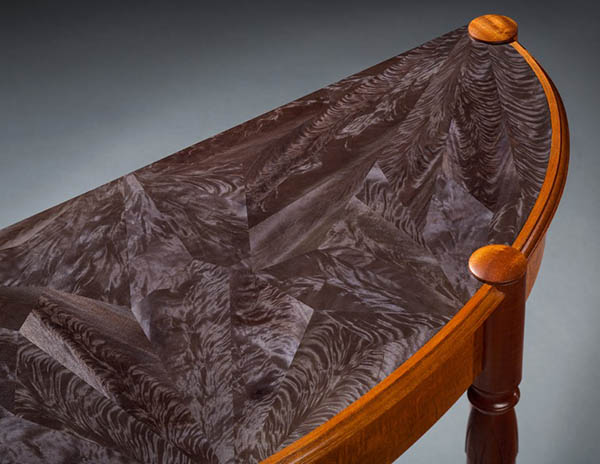
“My first attempts were a disaster because the dye was so intense. By the time you got the finish on, you don’t see anything,” he said. Through experimentation, he ended up with a process of several passes of very light spray, to build up the black Behlen Solar-Lux™ non-grain raising dye and “ghost” it onto the piece. “When you finish the material, it’s not just gray or black, but lots of colors. It will often translate to a gray or blue tone,” David said. It’s like looking up at cirrus clouds high in the sky, he explained: “They’re up so high you’ll see a rainbow effect. That’s from crystallization, the light refracting and getting diffused.”
The wood David uses for this effect is veneer; not commercially available veneer but pieces he makes after sourcing trees, whether from loggers or property owners, then having them cut with a sawmill, and drying the wood if it’s acceptable to his use. David then blends the pieces of birch together in a fractal pattern to represent frost.
He will make a full-size drawing of what he would like to see as the crystal pattern, then print it. “Then I’ll cut out it and basically glue it to the piece of veneer that I think is appropriate for that shape,” David said. “Then comes the painstaking work of cutting and fitting and gluing it together.”
“All the pieces are numbered,” he said; in the case of the Acadia cabinet, there are 50 pieces of veneer for each door, which were numbered 1 through 50 left, and 1 through 50 right. The patterns on each door are not symmetrical, but they are balanced, David said. Each door is one panel of fitted-together veneer glued to a substrate, which in this case is poplar, although David said he thinks a number of other materials would work as well. In this case, however, he wanted the stability of poplar: the doors are also curved, an effect created via a lamination assembly.
For the most part, David said, he wanted to use New England woods in the making of the Acadia cabinet. The lower portions of the legs and the sides of the cabinet are made from curly maple, with the interior panel representing the other three seasons carved in red birch. While red birch is the heartwood of the tree, rather than a separate species, “I wanted something soft and buttery-looking, but I wanted more of a homogenous grain structure,” David said.
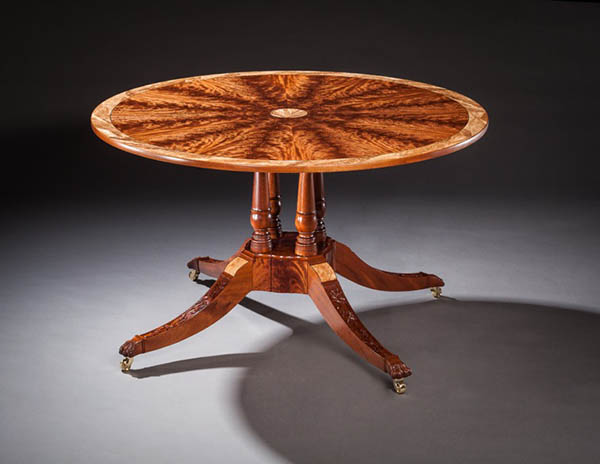
Most of his carving in the rest of his body of work has been done on mahogany or – for larger, architectural pieces – on pine, but David said the red birch was pleasant to work with as he used his gouges and chisels to create a scene. It’s not based on any specific bridge or particular carriage road, he said, but instead, “I made the bridge the way I wanted it to look. I put the mountain in the distance because I wanted to pay homage to Cadillac Mountain. It needed to tell a story.”
The flora represented in the carving brings the seasons from spring through fall, with images of jack-in-the-pulpit and blue flag (wild iris) wildflowers, as well as the leaves and branches of sugar maple and white pine trees. All of the plants represented are personal favorites of David’s.
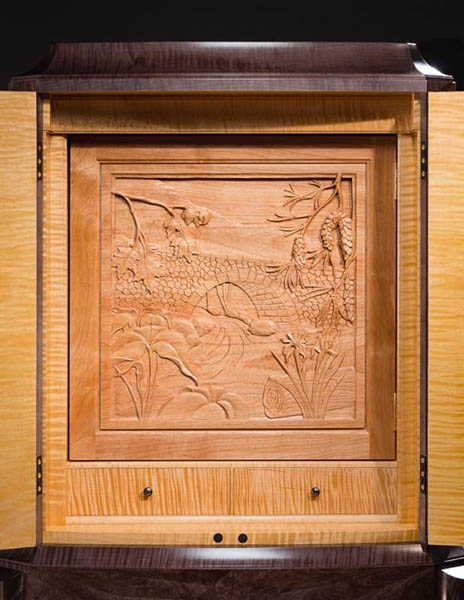
David drew on his personal experiences with Acadia National Park when creating the scene: he traveled often in the area with his parents during his childhood, and, when he has returned as an adult, “I go back and see the waves crashing at Thunder Hole, Cadillac Mountain, the carriage roads, the stone arch bridge; all that comes back. It’s a dramatic place; I definitely liked the sense of wilderness.”
With the cabinet, he said, “It completely changes the seasons when you open the doors. The warm gold comes through, and the scenery of the carving pulls out the other seasons.”
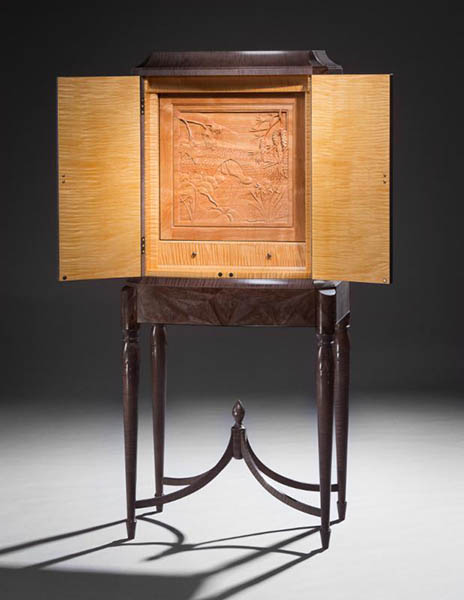
Back on the exterior of the cabinet, in addition to the doors, David’s black ice technique is also applied to the aprons, upper legs and corners. The upper legs have both a cylinder and a bell shape to the upper part of their turning, and “It was a very painstaking process, cutting and fitting on the curve” with the veneer, David said. Carvings on the legs – which were carved out of the solid wood, not applied — are meant to indicate dripping and represent melting ice.
David has used similar leg forms on many of the demilune tables he has made in his broader body of work, as well as the upward curving brace structure which connects the cabinet’s legs, as well as using the black ice process on other pieces before Acadia.
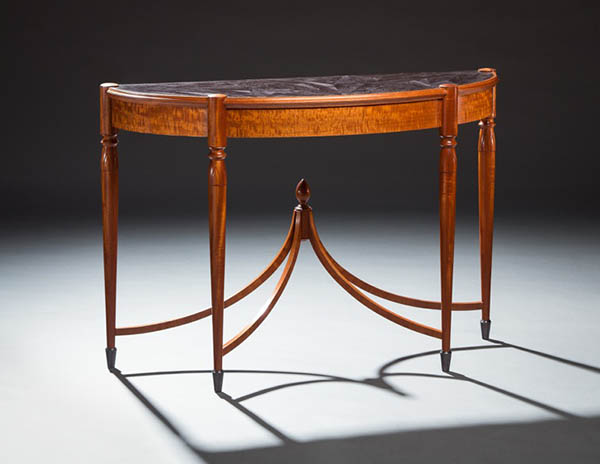
The non-black ice birch portions of the cabinet’s exterior are also dyed black – a process that David completes with “help from my next door neighbor and good friend, Tom McLaughlin.” Also a member, along with David, of the New Hampshire Furniture Masters Association, Tom, David said, “is a master with a spray gun. I go to his shop with a piece, and I’m the art director. He’s the guy physically putting it on. I’m saying, ‘More here.’ ‘Watch out for this corner.’ That kind of thing.”
His wife, Janet, also helps with applying the final finish, which is a clear shellac. “She sands and steel wools it and wipes it while I’m dealing with hardware,” David said. “It’s a good association with all the different people here,” including, in this case, the gallery owner and patron, who “pleased me no end to have a patron willing to let me express my ideas as freely as this patron did.”
The “Four Seasons of Acadia” cabinet will be on display at The Gallery at Somes Sound in Somesville, Maine, until October 31, 2016, as part of the “Acadia Through a Furniture Maker’s Eyes” exhibit. After that? It’s for sale, with a portion of the proceeds going to the Friends of Acadia.





